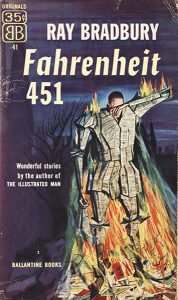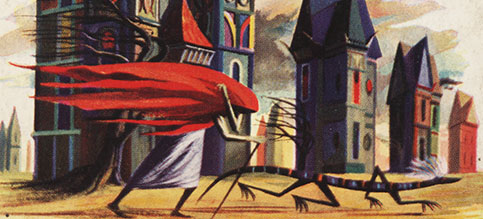This post is written by Jack Gleeson, Special Collections Assistant in the Foyle Special Collections Library at King’s.
‘What kind of people go up in roller coasters?’
Ralph Banghart rolled his cigar a full thirty seconds. ‘People wanna die. That rollie coaster’s the handiest thing to dying there is.’
(From: Ray Bradbury, ‘The dwarf’ in The October country, 1955).

© 1963, HP Lovecraft.
Nestled amongst the Norman Mailer and the Elmore Leonard in the Mottram collection is a neat run of science-fiction and horror paperbacks, predominantly published in the 1950s and 60s. Professor Eric Mottram (1924-95), Professor of English and American Literature at King’s from 1982 to 1990, was far from picky when amassing his library collection, leaving some gems of mid-20th century speculative fiction as part of our holdings in the Foyle Special Collections Library.
This blogpost marks the first of a two-part look at these items and further information about Mottram’s collection is available here.
 Ray Bradbury, science-fiction pioneer, is represented with a number of items in the Mottram collection, not least of which is a first paperback edition of his most widely-known work: Fahrenheit 451. Damaged, but thankfully not burnt, this edition was published by Ballantine Books in 1953 (simultaneous with the book’s first hardback edition, and only a year after the company’s founding), and is appended by two short stories.
Ray Bradbury, science-fiction pioneer, is represented with a number of items in the Mottram collection, not least of which is a first paperback edition of his most widely-known work: Fahrenheit 451. Damaged, but thankfully not burnt, this edition was published by Ballantine Books in 1953 (simultaneous with the book’s first hardback edition, and only a year after the company’s founding), and is appended by two short stories.
The novel, famed for its decrying of censorship, was Bradbury’s second, following The Martian chronicles, and was Ballantine’s 41st original paperback publication, priced at 35₵ and intended for drugstore racks. Fahrenheit 451 marked the publisher’s swift adoption of science-fiction into their repertoire – having started out with crime and Western novels, they branched out early on by publishing Star science fiction stories in 1953, and, that same year, Frederik Pohl’s and CM Kornbluth’s The space merchants.
 Joseph Mugnaini’s striking cover illustration for Fahrenheit 451 bears a secret, however: hidden amongst the folds of the central figure’s newspaper attire is the phrase ‘gothic ages.’ Bradbury, Illinois-born conjurer of autumnal fictions, has his love of the macabre intimated even here, and this dark heart is embellished in another Mottram collection item: a rare 1955 reprint of Bradbury’s The October country, also published by Ballantine.
Joseph Mugnaini’s striking cover illustration for Fahrenheit 451 bears a secret, however: hidden amongst the folds of the central figure’s newspaper attire is the phrase ‘gothic ages.’ Bradbury, Illinois-born conjurer of autumnal fictions, has his love of the macabre intimated even here, and this dark heart is embellished in another Mottram collection item: a rare 1955 reprint of Bradbury’s The October country, also published by Ballantine.
This (not to be biased) perfect short story collection contains haunted tales ripe for Hallowe’en digestion: ‘The lake’ (inspired by a tragic incident Bradbury witnessed in his youth), ‘Homecoming’ (which somewhat evokes The Addams family or The Munsters), and the touching, creepy story ‘The emissary’ (which tells the tale of a young bedridden boy who sends his dog to bring things back from the outside world) are all designed to be read to the sound of dead leaves being blown past the window. The majority had been featured in earlier forms in Dark carnival (published by August Derleth and his company Arkham House in 1947), and retain their sense of morbidity, merging ruminations on death with ruminations on mid-20th century life.
Happily, Bradbury is one of the most heavily represented authors in the Mottram collection: the Foyle Special Collections Library holds not just the above, but also rare editions and reprints of The Martian chronicles, The illustrated man, The golden apples of the Sun, A medicine for melancholy, and The wonderful ice cream suit and other plays – all published by Bantam Books.
The year before Bradbury’s very first short story was published in Imagination in 1938, one of speculative fiction’s greatest benefactors had passed away. Howard Phillips Lovecraft, Rhode Island-born conjurer of indescribable tentacular fictions, is behind a small, eclectic set of paperbacks found in the Mottram collection. Not having achieved widespread fame in the 1920s and 30s, Lovecraft’s stories found homes at the same imprints responsible for numerous crime, Western, horror, and science-fiction works in the following decades.
Included in our special collections are rare editions of The case of Charles Dexter Ward (prominently featuring an asylum – Gotham City’s own Arkham Asylum is in fact named after Lovecraft’s fictional town), and The haunter of the dark, which collects some of the author’s best-known stories, including ‘The call of Cthulhu,’ ‘The rats in the walls,’ and ‘The Dunwich horror.’ Panther Books followed up these 1963 reprints with Tales of the Cthulhu mythos in 1975, a multi-volume set which consisted chiefly of stories set in Lovecraft’s universe but written by other authors, such as August Derleth (Lovecraft’s early publisher), Clark Ashton Smith, and Robert E Howard. The cover of the first volume, held in the Foyle Special Collections Library, features a nicely moustachioed Cthulhu.

© 1963, HP Lovecraft.
1975 also saw Panther’s reprint of Lovecraft: a look behind the Cthulhu mythos by Lin Carter, first published three years earlier, and accompanying all of the above is a rare edition of Lovecraft: a biography, written by L Sprague de Camp and published by Ballantine in 1976 (first published a year prior). This abridged edition contains much fascinating discussion on the author’s early life, its influence on his weird and fantastical visions, and includes significant conversation pertaining to Lovecraft’s disparaging views on race.
To head, finally, back farther still: most are unlikely to think immediately of The lady of the shroud or The jewel of seven stars when asked to name works by Bram Stoker, yet rare paperback reprints of these appear in place of Dracula, in the Mottram collection. These Arrow Books were published in 1962 – The lady of the shroud takes a non-supernatural twist, while The jewel of seven stars was very loosely adapted into the 2017 Tom Cruise/Russell Crowe bonanza The mummy, and elements of the television series Penny dreadful. The latter book, originally published in 1903, features the text of a 1912 edition, in which the ending was rewritten by Stoker, and a chapter on religion was removed. The final paragraph of the revised 1912 edition, and this Arrow Book, reads:
‘Do not grieve for her! […] She dreamed her dream, and that is all any of us can ask!’
While the original 1903 edition ends rather more damningly:
It was merciful that I was spared the pain of hoping.
All of these Mottram collection items are making their way through our cataloguers and onto our shelves – we are naturally happy to answer any and all enquiries pertaining to our Special Collections.
Please stay tuned for part 2, in which we turn to robots and rocketships…
The cover illustrations shown here are reproduced courtesy of Penguin Random House; and HarperCollins Publishers Ltd.

Leave a comment